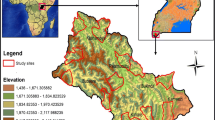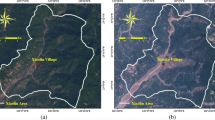Abstract
Several researchers have evaluated landslide susceptibility using various factors, and only few have focused on only one landslide impacting factor in detail, especially its response to geomorphologic evolution. Slope aspect is one of the key conditioning factors for landslide susceptibility assessment in fine-scale studies. To elucidate the slope aspect effect of loess slides and its spatial differentiation, we selected three study areas with different geomorphologic settings in the Chinese Loess Plateau, and developed landslide inventory through the interpretation of remote sensing images and intensive field survey. By using GIS and statistical approach, including extreme ratio and coefficient of variation, we characterized the distribution of loess slides in different slope aspects and compared their spatial differentiation. The results showed that the slope aspect has a significant influence on the spatial distribution of loess slides. The number and area of loess slide is higher in south-facing slope in all the three counties. Moreover, the slope aspect effects on loess slides were mediated by the geomorphologic types. The more mature the development of geomorphology, the more obvious is the slope aspect effect on the landslide. This study is very important for the study on geomorphologic evolution of Loess Plateau.









Similar content being viewed by others
References
Aleotti P, Chowdhury R (1999) Landslide hazard assessment: summary review and new perspectives. Bull Eng Geol Environ 58(1):21–44
Ayalew L, Yamagishi H (2005) The application of GIS-based logistic regression for landslide susceptibility map** in the Kakuda-Yahiko Mountains, Central Japan. Geomorphology 65(1):15–31
Buma B, Johnson AC (2015) The role of windstorm exposure and yellow cedar decline on landslide susceptibility in southeast Alaskan temperate rainforests. Geomorphology 228:504–511
Brardinoni F, Church M (2004) Representing the landslide magnitude–frequency relation: Capilano river basin, British Columbia. Earth Surf Process Landf 29(1):115–124
Capitani M, Ribolini A, Bini M (2013) The slope aspect: a predisposing factor for landsliding? Compt Rendus Geosci 345(11):427–438
Carrara A, Cardinali M, Detti R, Guzzetti F, Pasqui V, Reichenbach P (1991) GIS techniques and statistical models in evaluating landslide hazard. Earth Surf Process Landf 16(5):427–445
Carrara A, Catalano E, Sorriso-Valvo M, Reali C, Osso I (1978) Digital terrain analysis for land evaluation. Geologia Applicata e Idrogeologia 13:69–127
Cevik E, Topal T (2003) GIS-based landslide susceptibility map** for a problematic segment of the natural gas pipeline, Hendek (Turkey). Environ Geol 44(8):949–962
Cruden DM, Varnes DJ (1996) Landslide types and processes. In: Turner, AK, Schuster, RL (Eds), Landslides: Investigation and Mitigation (Special Report) Washington, DC, USA: National Research Council, Transportation and Research Board Special Report Vol. 247, pp. 36–75
Dai FC, Lee CF, Li J, Xu ZW (2001) Assessment of landslide susceptibility on the natural terrain of Lantau Island, Hong Kong. Environ Geol 40(3):381–391
Dai FC, Lee CF (2002) Landslide characteristics and slope instabilitymodelling using GIS,Lantau Island, Hong Kong. Geomorphology 42:213–228
Derbyshire E, Mellors TW (1988) Geological and geotechnical characteristics of some loess and loessic soils from China and Britain: a comparison. Eng Geol 25:135–175
Derbyshire E, Dijkstra TA, Smalley IJ, Li YJ (1994) Failure mechanisms in loess and the effects of moisture content changes on remolded strength. Quat Int 24:5–15
Derbyshire E, Meng XM, Dijkstra TA (2000) Landslides in the thick loess terrain of North-West China. John Wiley & Sons Ltd, London
Derbyshire E (2001) Geological hazards in loess terrain, with particular reference to the loess regions of China. Earth Sci Rev 54(1):231–260
Frechen M (2011) Loess in europe. E & G Quaternary Science Journal 60(1):3–5
Gao GR (1988) Formation and development of the structure of collapsing loess in China. Eng Geol 25:235–245
Guo C, Montgomery DR, Zhang Y, Wang K, Yang Z (2015) Quantitative assessment of landslide susceptibility along the **anshuihe fault zone, Tibetan Plateau, China. Geomorphology 248:93–110
Guthrie RH, Evans SG (2004a) Magnitude and frequency of landslides triggered by a storm event, Loughborough Inlet, British Columbia. Nat. Hazards Earth Syst Sci 4(3):475–483
Guthrie RH, Evans SG (2004b) Analysis of landslide frequencies and characteristics in a natural system, coastal British Columbia. Earth Surf Process Landf 29(11):1321–1339
Guzzetti F, Ardizzone F, Cardinali M, Galli M, Reichenbach P, Rossi M (2008) Distribution of landslides in the Upper Tiber River basin, Central Italy. Geomorphology 96(1–2):105–122
Guzzetti F, Ardizzone F, Cardinali M, Rossi M, Valigi D (2009) Landslide volumes and landslide mobilization rates in Umbria, Central Italy. Earth Planet Sci Lett 279(3):222–229
Guzzetti F, Carrara A, Cardinali M, Reichenbach P, Galli M, Ardizzone F (1999) Landslide hazard evaluation: an aid to a sustainable development. Geomorphology 31:181–216
Guzzetti F, Reichenbach P, Ardizzone F, Cardinali M, Galli M (2006) Estimating the quality of landslide susceptibility models. Geomorphology 81(1):166–184
Guzzetti F, Reichenbach P, Cardinali M, Galli M, Ardizzone F (2005) Probabilistic landslide hazard assessment at the basin scale. Geomorphology 72(1):272–299
Gritzner ML, Marcus WA, Aspinall R, Custer SG (2001) Assessing landslide potential using GIS, soil wetness modeling and topographic attributes, Payette River, Idaho. Geomorphology 37(1):149–165
Korup O, Densmore AL, Schlunegger F (2010) The role of landslides in mountain range evolution. Geomorphology 120(1):77–90
Larsen MC, Torres-Sánchez AJ (1998) The frequency and distribution of recent landslides in three montane tropical regions of Puerto Rico. Geomorphology 24(4):309–331
Li, T.L.,Wang, C.Y., Li, P., 2013. Loess deposit and loess landslides on the Chinese Loess Plateau.In: Wang, F., et al. (Eds.), Progress of Geo-Disaster Mitigation Technology in Asia. Environmental Science and Engineering. Springer-Verlag, Berlin Heidelberg, pp. 235–261
Lin ZG, Wang SJ (1988) Collapsibility and deformation characteristics of deep-seated loess in China. Eng Geol 25:271–282
Liu TS (1985) Loess and environment. China Ocean Press, Bei**g
Malamud BD, Turcotte DL, Guzzetti F, Reichenbach P (2004) Landslide inventories and their statistical properties. Earth Surf Process Landf 29(6):687–711
Marston RA, Miller MM, Devkota LP (1998) Geoecology and mass movements in the Manaslu Ganesh and Langtang-Jural Himals, Nepal. Geomorphology 26:139–150
Meinhardt M, Fink M, Tünschel H (2015) Landslide susceptibility analysis in central Vietnam based on an incomplete landslide inventory: comparison of a new method to calculate weighting factors by means of bivariate statistics. Geomorphology 234:80–97
Nagarajan R, Roy A, Kumar RV, Mukherjee A, Khire MV (2000) Landslide hazard susceptibility map** based on terrain and climatic factors for tropical monsoon regions. Bull Eng Geol Environ 58(4):275–287
Pan JH, ** XT, Han EC (2011) Landscape patterns and spatial distribution characteristics of rural residential areas in Gangu County. Journal of Northwest University (Natural Science Edition) 41(1):127–133
Qiu H, Regmi AD, Cui P, Cao M, Lee J, Zhu X (2016) Size distribution of loess slides in relation to local slope height within different slope morphologies. Catena 145:155–163
Stark CP, Hovius N (2001) The characterization of landslide size distributions. Geophys Res Lett 28(6):1091–1094
Temesgen B, Mohammed MU, Korme T (2001) Natural hazard assessment using GIS and remote sensing methods, with particular reference to the landslides in the Wondogenet area,Ethiopia. Phys Chem Earth Part C 26:665–675
Trigila A, Iadanza C, Esposito C, Scarascia-Mugnozza G (2015) Comparison of logistic regression and random forests techniques for shallow landslide susceptibility assessment in Giampilieri (NE Sicily, Italy). Geomorphology 249:119–136
Varnes DJ (1984) Landslide hazard zonation: a review of principles and practice. The UNESCO Press, Paris
Wieczorek GF, Mandrone G, DeCola L (1997) The influence of hillslope shape on debris-flow initiation. In: Chen CL (ed) Debris-flow hazards mitigation: mechanics, prediction, and assessment. American Society of Civil Engineers, New York, pp 21–31
Yalcin A (2008) GIS-based landslide susceptibility map** using analytical hierarchy process and bivariate statistics in Ardesen (Turkey): comparisons of results and confirmations. Catena 72(1):1–12
Yilmaz I (2009) Landslide susceptibility map** using frequency ratio, logistic regression, artificial neural networks and their comparison: a case study from Kat landslides (Tokat—Turkey). Comput Geosci 35(6):1125–1138
Zhang D, Wang G (2007) Study of the 1920 Haiyuan earthquake-induced landslides in loess (China). Eng Geol 94(1):76–88
Zhang F, Chen W, Liu G, Liang S, Kang C, He F (2012a) Relationships between landslide types and topographic attributes in a loess catchment, China. J Mt Sci 9(6):742–751
Zhang C, Ren ZY, Li XY (2012b) Research on vegetation response to temperature and precipitation in Loess Plateau. Sci Agric Sin 45(20):4205–4215
Zhang F, Pei X, Chen W, Liu G, Liang S (2014) Spatial variation in geotechnical properties and topographic attributes on the different types of shallow landslides in a loess catchment, China. European Journal of Environmental and Civil Engineering 18:470–488
Zhang M, Liu J (2010) Controlling factors of loess landslides in western China. Environmental Earth Sciences 59(8):1671–1680
Zhou CH, Lee CF, Li J, Xu ZW (2002a) On the spatial relationship between landslides and causative factors on Lantau Island, Hong Kong. Geomorphology 43(3–4):197–207
Zhou JX, Zhu CY, Zheng JM, Wang XH, Liu ZH (2002b) Landslide disaster in the loess area of China. J For Res 13(2):157–161
Acknowledgements
This research was supported by the international partnership program of the Chinese Academy of Sciences (Grant No. 131551KYSB20160002), National Natural Science Foundation of China (Grant No. 41401602), and Natural Science Basic Research Plan in Shaanxi Province of China (Program No.2014JQ2-4021).
Author information
Authors and Affiliations
Corresponding author
Rights and permissions
About this article
Cite this article
Qiu, H., Regmi, A.D., Cui, P. et al. Slope aspect effects of loess slides and its spatial differentiation in different geomorphologic types. Arab J Geosci 10, 344 (2017). https://doi.org/10.1007/s12517-017-3135-5
Received:
Accepted:
Published:
DOI: https://doi.org/10.1007/s12517-017-3135-5




